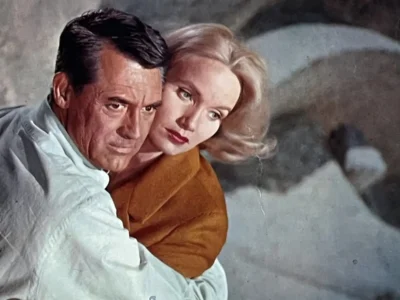
The MacGuffin
Definition
A MacGuffin is an element relevant to character motivation and the progression of the narrative, but the object or event itself is insignificant. The MacGuffin could be a mysterious artifact, an heirloom, classified military documents, a missing person, a computer program, a priceless work of art, or a weapon capable of destroying the planet.
Although the audience will understand the importance of the element and appreciate the reasons why the characters are searching for it, the MacGuffin does not take on a deeper meaning beyond its function to create the external conflict.
North By Northwest
The “microfilm” in Afred Hitchcock’s classic thriller North by Northwest (1959) is a great example of a MacGuffin because it is the “desperately important reason” for all the action throughout the story, but its actual contents are never revealed to the audience.
The film begins with a case of mistaken identity. The villains believe Roger Thornhill, an advertising executive, is an undercover agent called George Kaplan. Bundled into a car by henchmen, assaulted “with a gun and a bourbon and a sports car”, and framed for the murder of a diplomat, Thornhill goes on the run from the police and tries to uncover the truth behind his extraordinary situation.
In terms of narrative structure, we get a partial answer to the enigma code when Thornhill learns the villain is “an importer and exporter” of “government secrets”. The microfilm is introduced several scenes later, but it is hidden in the “belly” of a “little treasure”.

Even Thornhill dismisses the significance of the statue, calling it a “pumpkin”.
The microfilm could contain images of military plans or a list of spies operating in Eastern Europe. We don’t need to know because the content is irrelevant to our enjoyment of the film. Its only purpose in the narrative is to justify the thrilling chase.
The Semiotics of MacGuffins
Semiotic theory can help explain how MacGuffins work. If you have read our introduction to Ferdinand de Saussure, you already know he divided signs into two parts: the physical form (signifier) and the mental concept (signified).
There is no doubt the microfilm drives the action in North by Northwest. Phillip Vandamm, the villain, wants to smuggle the secrets out of the country and sell them to the Soviets. He believes George Kaplan is a government agent who is trying to stop his operation, so he orders the threat to be eliminated. In the final sequence, Eve Kendall steals the statue, forcing the henchmen to chase our heroes down the Mount Rushmore monument.

However, the physical form of the MacGuffin does not matter. The signifier could easily have been a conversation recorded on audio tape, or a formula scribbled on a piece of paper, and the narrative would not be affected.

The microfilm is also an empty signifier because it does not have a fixed or stable meaning in the film. The MacGuffin is just something the characters are chasing. Its function is purely structural.
Origins of the Term
The plot device has been around for a long time. In Greek mythology, for example, Jason and the Argonauts were dispatched by the king on a quest to find the golden fleece. The golden fleece provided the reason for the epic journey, but its actual nature was irrelevant to the narrative. You might also be aware of the Holy Grail legends featuring a medieval knight in search of a sacred relic.
The Weenie
MacGuffins were an important narrative feature of silent films and serials in the early 1900s. Characters were motivated to retrieve stolen documents, discover the location of hidden treasure, find a missing necklace, or capture a superweapon. Since these films relied on visual storytelling, the details of the objects were never really explained to the audience.
A famous actress from the silent era called Pearl White used the term “weenie” to compare the action in some of her films to a dog chasing a sausage. In The Perils of Pauline (1914), for instance, the villains were always trying to steal her “large inheritance”. In this reworked version of the first episodes from the classic melodrama, Pauline is determined to “live a life full of excitement and adventure” before she marries her beloved and agrees to go on a “daring balloon ascent”.
Mr Koerner, a man “tainted by a stormy past”, is blackmailed by his “old crony” and is forced to “dispose” of Pauline so he can “gain control of all her property”. With the hot air balloon sabotaged, the young heiress makes a death-defying descent down a rope and cliff to safety. The escape from the burning building at the end of the episode is also spectacular.
Importantly, her inheritance provided the reason for the external conflict. Pearl White believed an insignificant sausage could have driven the narrative because she understood the audience were more interested in the exciting locations and dramatic stunts.
Although the serial format relied on “cliffhangers” to keep audiences coming back for the next episode, perhaps the cliff sequence provided some inspiration for the climax in North by Northwest.
The Springboard Incident
In 1939, Alfred Hitchcock gave a lecture on “melodrama and suspense” where he argued the first reel of a film should feature a “springboard situation” with a “sympathetic character” getting into trouble. Of course, the innocent Roger Thornhill finds himself in trouble because he is mistaken for Roger Kaplan, but the reason for the danger is a “mystery element” that Hitchcock hides from the audience until the revelation of the microfilm in the final act. This concept of the springboard situation is similar to the “weenie” which justified the action in the narrative but had no deeper meaning than a sausage.
The Etymology of MacGuffin
The word “guff” denotes a smelly puff of wind. Inevitably, the term was commonly used as a metaphor for someone talking nonsense and many teachers over the years have complained to their class, saying, “I’m fed up marking this guff.”
Perhaps MacGuffin is the personification of a bad smell that motivates the characters into action.
The term is believed to have been influenced by Angus MacPhail, the British screenwriter who worked closely with Alfred Hitchcock on several films. In The Man Who Knew Too Much (1934), for instance, a married couple are motivated by an assassination plot, but the real emotional focus is on their desperate attempt to save their child. Similarly, in Spellbound (1945), the melodrama between the two protagonists is more important than their motivation to uncover the mystery behind the identity and disappearance of Dr. Edwardes that sparks the story. The plot device in both films could easily have been replaced by another object or event and the narrative would still have entertained the audience.
The word MacGuffin is just as gibberish as the MacGuffin.
The Hitchcock MacGuffin
In a dialogue with François Truffaut (1966), Hitchcock described the MacGuffin as a “device” and a “gimmick”. He argued there was no point trying to understand the “truth” behind the characters determination to “steal plans or documents, or discover a secret” because the meanings were “beside the point”. MacGuffins are “of vital importance to the characters” but “they’re of no importance whatsoever” to the narrator or audience.
Hitchcock repeated this explanation to the talk-show host Dick Cavett in 1972, saying the MacGuffin was “always the thing that the characters on the screen worry about, but the audience don’t care”.
You can skip to the sixth minute for his definition. Hitchcock goes on to imagine “a scene in an English train going to Scotland”:
One man says to the other opposite him, he said, “What’s that package above your head there?”
And the other man said, “Oh, that that’s a MacGuffin.”
He said, “What is a MacGuffin?”
He said, “Well, It’s an apparatus for trapping lions in the Scottish Highlands.”
Man said, “But there are no lions in the Scottish Highlands.”
He said, “Then that’s no MacGuffin.”
The idea of a lion-catching device in Scotland is ridiculous, but so are most MacGuffins. However, once the passenger questions the purpose and importance of the apparatus, the MacGuffin ceases to exist. MacGuffins only work if the audience are willing to accept the “package” motivates the characters into action.
The George Lucas MacGuffin
George Lucas offered a broader definition of the MacGuffin in his films. Instead of being empty signifiers, his objects were more complex and had meanings beyond the function of character motivation.
In the DVD commentary for Wars: Episode IV – A New Hope (1977), the director described R2-D2 as “the main driving force of the movie” and “the MacGuffin which is the object of everybody’s search.” By placing the Death Star plans inside the little droid, Lucas connects the audience to the MacGuffin and makes us care about the character’s fate. It also enables the Rebel Alliance to exploit a weakness in the ultimate weapon and defeat the villains.
Another example is the Holy Grail in Indiana Jones and the Last Crusade (1989). Everyone is chasing the sacred relic. However, the MacGuffin has a more defined role in story because the protagonist uses its healing properties to save his father in the final sequence.

In both films, the MacGuffin has real meaning to the characters and the audience, rather than being a purely arbitrary plot device.
Final Thoughts
It’s useful to compare MacGuffins to other plot devices to get a better sense of their role in the narrative. For example, in his study of Russian fairy tales, Vladimir Propp described how the heroes often relied on a “magical object” to aid their quest and defeat the villain. If the microfilm had contained classified information that Thornhill was able to use to defeat Vandamm and rescue Kendall, then it would be a magical object rather than a MacGuffin.
It’s not a repair either in terms of Tzvetan Todorov’s narrative theory because the microfilm does not establish a new equilibrium. The protagonist simply manages to evade the villains and marries Kendall.
Remember, a MacGuffin is a device that provides motivation for the characters and sets events in motion, but its essence is irrelevant to the narrative.
Although the microfilm is suddenly and unexpectedly introduced to the audience towards the end of the narrative to help explain the villain’s motivation, the device is not a deus ex machina because its purpose is not to resolve the conflict. MacGuffins create conflict.
Another plot device worth considering is Chekhov’s gun. When the protagonist meets the double-agent, Eve Kendall, on the train, he offers her a light from his own branded matchbook.
Kendall assumes ROT are his initials and asks the fugitive what the “O” means. “Nothing,” he replies. The event does not appear to have any significance beyond developing the relationship between the two characters. However, Thornhill uses the matchbook in the final act to warn Kendall her life is in danger. It is a satisfying pay off.

A Chekhov’s gun seems irrelevant to the action but pays off in a meaningful way later in the narrative. By contrast, a MacGuffin provides a reason for the action but is meaningless to the audience.









